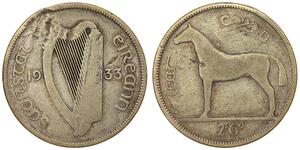(sold for $8.0)
1537, Latvia/Livonian Order, Riga (City). Scarce Silver Schilling Coin. aXF!
Mint Year: 1537 Denomination: Schilling Mint Place: Riga (Latvia) Reference: Neumann 246, Haljak 151. Condition: A few old edge-cuts (old silver-test cuts), otherwise about XF! Diameter: 19mm Weight: 1.01gm Material: Silver
Obverse: Cross above keys in saltire (arms of Riga). Legend: MONE . NO . RIGENSIS . 3 . 7 .
Reverse: Striped shield on long-cross, which splits legend. Legend: LIVO - HER D - BREC - HA . M .
Riga developed as the main merchandise centre of the Livonia Confederation and was a chain between merchants of Western Europe and Lands of Russia. In order to defend its trading interests, Riga joined the Hanseatic League during the late 13th century. Bishop Albert moved his residency here from Ikskile in 1201-02, thus establishing the Bishopric of Riga (the Archbishopric since 1255). Riga had its own coat of arms and flag since 1220's until 1581. When the Livonia Confederation was dissolved in 1561, Riga got the status of free city on the same year. This status lasted until 1581, when Riga had to accept the reign of Poland as the result of later phases of Livonia War.
The Livonian Order was an autonomous branch of the Teutonic Order, formed in 1237. It was later a member of the Livonian Confederation, from 1435 to 1561.
The order was formed from the remnants of the Livonian Brothers of the Sword after their defeat by Samogitians in 1236 at the Battle of Schaulen (Saule). They were incorporated into the Teutonic Knights and became known as the Livonian Order in 1237. Between 1237 and 1290, the Livonian Order conquered all of Courland, Livonia and Semigallia. In 1298, Lithuanians took Karkus Castle north of Riga, and defeated the order in the Battle of Turaida, killing Livonian Land Master Bruno and 22 knights. In 1346, the order bought the Duchy of Estonia from King Valdemar IV of Denmark. Life within the order's territory is described in the Chronicle of Balthasar Russow (Chronica der Provinz Lyfflandt).
The Teutonic Order fell into decline following its defeat in the Battle of Grunwald in 1410 and the secularization of its Prussian territories by Albert of Brandenburg in 1525, while the Livonian Order managed to maintain an independent existence.
The Livonian Order's defeat in the Battle of Swienta (Pabaiskas) on September 1, 1435, which claimed the lives of the master and several high-ranking knights, brought the order closer to its neighbors in Livonia. The Livonian Confederation agreement (eiine fruntliche eyntracht) was signed in Walk on December 4, 1435, by the Archbishop of Riga, the bishops of Courland, Dorpat, Ösel-Wiek and Reval; the representatives of the Livonan Order and vassals, and the deputies of Riga, Reval and Dorpat city municipal councils.
During the Livonian War, however, the order suffered a decisive defeat by troops of Muscovite Russia in the Battle of Ergeme in 1560. The Livonian Order then sought protection from Sigismund II Augustus, the King of Poland and the Grand Duke of Lithuania, who had intervened in a war between Bishop William of Riga and the Brothers in 1557.
After coming to an agreement with Sigismund II, Augustus and his representatives (especially Mikołaj "the Black" Radziwiłł), the last Livonian Master, Gotthard Kettler, secularized the order and converted to Lutheranism. In the southern part of the Brothers' lands he created the Duchy of Courland and Semigallia for his family. Most of the remaining lands were seized by the Grand Duchy of Lithuania. The north of Estonia was taken back by Denmark and Sweden.
From the 14th to the 16th centuries, Middle Low German as spoken in the towns of the Hanseatic League was the established language, but was subsequently succeeded by High German as official language in the course of the 16th and 17th centuries.
Only 1$ shipping for each additional coin purchased!

|
Posted by:
anonymous 2018-08-21 |
2 Stuiver Netherlands Silver
group has 33 coins / 33 prices
⇑
1/2 Crown Ireland (1922 - )
group has 44 coins / 43 prices
⇑






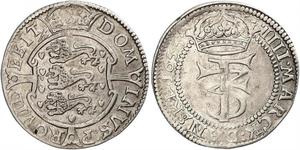
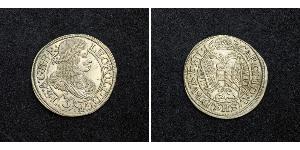

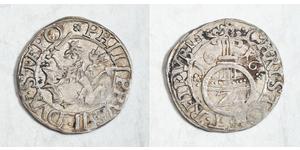

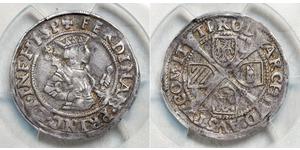



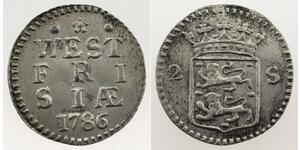
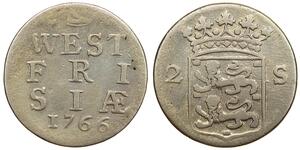
-300-150-cqgKbzbiQeMAAAFLYpCjltiK.jpg)
